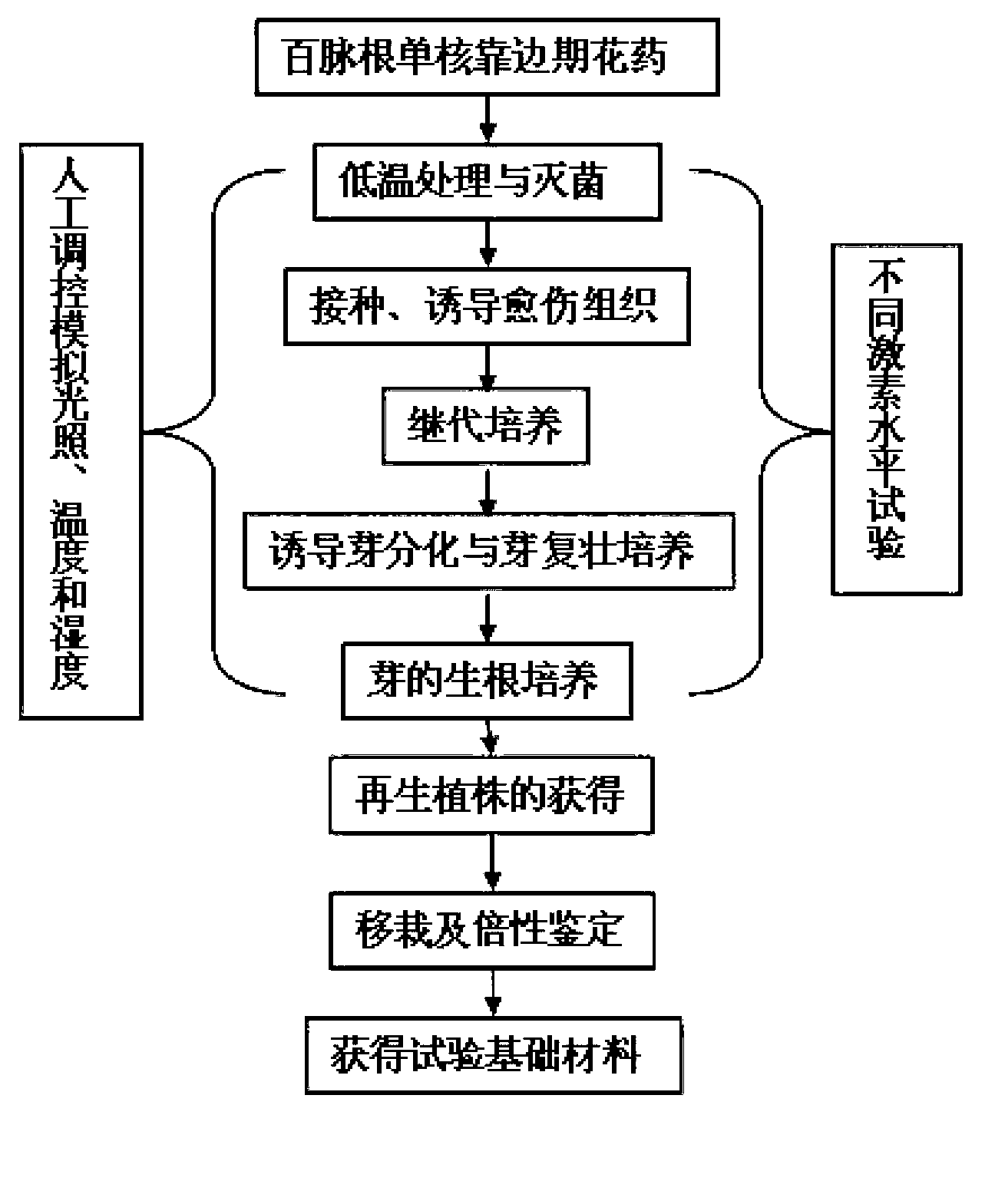Method for obtaining crowtoe regeneration plantlet by anther culture
A technology for regenerating plants and L. japonicus, applied in the fields of botanical equipment and methods, plant regeneration, horticultural methods, etc., can solve the problems of self-incompatibility, slow breeding process, poor efficiency, etc. Effects of gene function
- Summary
- Abstract
- Description
- Claims
- Application Information
AI Technical Summary
Problems solved by technology
Method used
Image
Examples
Embodiment 1
[0014] Embodiment 1. The anthers of Lotus corniculatus Linn (Lotus corniculatus Linn) in the uninucleated marginal stage were used as explants, and the regenerated plants of Lotus corniculatus Linn were obtained by in vitro culture.
[0015] The operation process is as figure 1 , the specific process is as follows:
[0016] a. Selection of anthers in the single-nucleus stage of japonicus japonicus japonicus
[0017] 1) The commercially available variety "Leo" of japonicus japonicus was selected as the material. It was sown in early October and started in late April of the following year. Collect about 2mm, green, bracts from 9:00 am to 11:00 am on sunny days. The flower buds are as long as the flower buds and are in the shape of a knife point (use magenta acetate dyeing and pressing method to observe and determine the development stage). Most of the flower buds at this time are in the single-core stage.
[0018] 2) Put the above flower buds into a small kraft paper bag, tak...
Embodiment 2
[0055] The difference between this embodiment and embodiment 1 is:
[0056] ①The formula of callus induction medium was NB+2,4-D1.0mg / L+NAA0.6mg / L+KT2.0mg / L, sucrose 90g / L, agar 6g / L, pH5.8.
[0057] ②The formula of differentiation medium is MS+KT1.0mg / L+NAA0.5mg / L, sucrose 30g / L, agar 6g / L, pH58.
[0058] ③The rooting medium is 1 / 2MS+NAA0.3mg / L, sucrose 10g / L, agar 6g / L, pH5.8.
[0059] ④ Replace the transplanting sterilization matrix with field soil.
[0060] Under the hormone level, the callus induction rate was 29.17%, the differentiation rate was 13.21%, and the rooting rate was 68.89%. The survival rate of transplanting by the method of ④ was 34.21%.
Embodiment 3
[0062] The difference between this embodiment and embodiment 1 is:
[0063] ①The formula of callus induction medium was NB+2,4-D1.5mg / L+NAA0.6mg / L+KT2.0mg / L, sucrose 90g / L, agar 6g / L, pH5.8.
[0064] ②The formula of differentiation medium is MS+KT1.5mg / L+NAA1mg / L, sucrose 30g / L, agar 6g / L, pH5.8.
[0065] ③The rooting medium is 1 / 2MS+NAA0.7mg / L, sucrose 10g / L, agar 6g / L, pH5.8.
[0066] ④ Replace the transplanting sterilized matrix formula transplanting matrix with full nutrient soil.
[0067] Under this hormone level, the callus induction rate was 51.2%, the differentiation rate was 15.68%, and the rooting rate was 55.81%. The survival rate of transplanting by the method of ④ was 60.97%.
PUM
 Login to View More
Login to View More Abstract
Description
Claims
Application Information
 Login to View More
Login to View More - Generate Ideas
- Intellectual Property
- Life Sciences
- Materials
- Tech Scout
- Unparalleled Data Quality
- Higher Quality Content
- 60% Fewer Hallucinations
Browse by: Latest US Patents, China's latest patents, Technical Efficacy Thesaurus, Application Domain, Technology Topic, Popular Technical Reports.
© 2025 PatSnap. All rights reserved.Legal|Privacy policy|Modern Slavery Act Transparency Statement|Sitemap|About US| Contact US: help@patsnap.com



